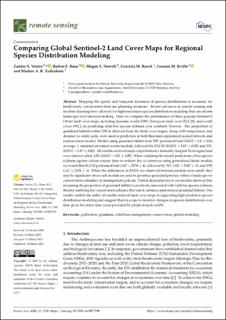| dc.contributor.author | Venter, Alexander Samuel | |
| dc.contributor.author | Roos, Ruben Erik | |
| dc.contributor.author | Nowell, Megan Sara | |
| dc.contributor.author | Rusch, Graciela Monica | |
| dc.contributor.author | Kvifte, Gunnar Mikalsen | |
| dc.contributor.author | Sydenham, Markus A. K. | |
| dc.date.accessioned | 2023-03-31T11:41:45Z | |
| dc.date.available | 2023-03-31T11:41:45Z | |
| dc.date.created | 2023-03-24T10:27:08Z | |
| dc.date.issued | 2023 | |
| dc.identifier.citation | Venter, Z. S., Roos, R. E., Nowell, M. S., Rusch, G. M., Kvifte, G. M., & Sydenham, M. A. K. (2023). Comparing global Sentinel-2 land cover maps for regional species distribution modeling. Remote Sensing, 15(7), Article 1749. doi: | en_US |
| dc.identifier.issn | 2072-4292 | |
| dc.identifier.uri | https://hdl.handle.net/11250/3061452 | |
| dc.description.abstract | Mapping the spatial and temporal dynamics of species distributions is necessary for biodiversity conservation land-use planning decisions. Recent advances in remote sensing and machine learning have allowed for high-resolution species distribution modeling that can inform landscape-level decision-making. Here we compare the performance of three popular Sentinel-2 (10-m) land cover maps, including dynamic world (DW), European land cover (ELC10), and world cover (WC), in predicting wild bee species richness over southern Norway. The proportion of grassland habitat within 250 m (derived from the land cover maps), along with temperature and distance to sandy soils, were used as predictors in both Bayesian regularized neural network and random forest models. Models using grassland habitat from DW performed best (RMSE = 2.8 ± 0.03; average ± standard deviation across models), followed by ELC10 (RMSE = 2.85 ± 0.03) and WC (RMSE = 2.87 ± 0.02). All satellite-derived maps outperformed a manually mapped Norwegian land cover dataset called AR5 (RMSE = 3.02 ± 0.02). When validating the model predictions of bee species richness against citizen science data on solitary bee occurrences using generalized linear models, we found that ELC10 performed best (AIC = 2278 ± 4), followed by WC (AIC = 2367 ± 3), and DW (AIC = 2376 ± 3). While the differences in RMSE we observed between models were small, they may be significant when such models are used to prioritize grassland patches within a landscape for conservation subsidies or management policies. Partial dependencies in our models showed that increasing the proportion of grassland habitat is positively associated with wild bee species richness, thereby justifying bee conservation schemes that aim to enhance semi-natural grassland habitat. Our results confirm the utility of satellite-derived land cover maps in supporting high-resolution species distribution modeling and suggest there is scope to monitor changes in species distributions over time given the dense time series provided by products such as DW. pollinators; grassland; wild bees; management; conservation; spatial modeling | en_US |
| dc.language.iso | eng | en_US |
| dc.publisher | MDPI | en_US |
| dc.rights | Navngivelse 4.0 Internasjonal | * |
| dc.rights.uri | http://creativecommons.org/licenses/by/4.0/deed.no | * |
| dc.title | Comparing global Sentinel-2 land cover maps for regional species distribution modeling | en_US |
| dc.type | Peer reviewed | en_US |
| dc.type | Journal article | en_US |
| dc.description.version | publishedVersion | en_US |
| dc.rights.holder | © 2023 The Authors | en_US |
| dc.subject.nsi | VDP::Matematikk og naturvitenskap: 400 | en_US |
| dc.subject.nsi | VDP::Mathematics and natural scienses: 400 | en_US |
| dc.source.volume | 15 | en_US |
| dc.source.journal | Remote Sensing | en_US |
| dc.source.issue | 7 | en_US |
| dc.identifier.doi | 10.3390/rs15071749 | |
| dc.identifier.cristin | 2136632 | |
| dc.relation.project | The Research Council of Norway: 160022 | en_US |
| dc.relation.project | Norwegian Agricultural Agency (Klima-og Miljøprogrammet: POLLILAND): 2018/72806 | en_US |
| dc.relation.project | Norwegian Agricultural Agency (Klima-og Miljøprogrammet: POLLILAND-MIDT): 2021/40219 | en_US |
| dc.source.articlenumber | 1749 | en_US |

